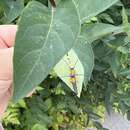fi
nimet breadcrumb-navigoinnissa


Der Geißblatt-Linienbock, auch Heckenkirschen-Linienbock (Oberea pupillata) ist ein Käfer aus der Familie der Bockkäfer (Cerambycidae).
Der Geißblatt-Linienbock ist 16 bis 18, nach anderen Quellen 13 bis 18 Millimeter lang. Er hat ein oranges Halsschild mit zwei länglichen schwarzen Flecken darauf. Die Beine, die Innenseite der Flügeldeckenbasis und die Körperunterseite sind ebenfalls orange. Die Flügeldecken sind grau behaart. Er ist für einen Bockkäfer ziemlich schmal und erinnert daher an einen Weichkäfer.
Der Geißblattlinienbock kommt in Europa und Russland vor. In Mitteleuropa sind nur vereinzelte lokale Populationen zu finden, die man, wenn überhaupt, meistens an Waldrändern oder in Parks antrifft. In Letzteren tritt er allerdings manchmal in Massen auf. Als Beispiel dafür ist Prag zu nennen.[1]
Der Geißblatt-Linienbock ernährt sich während der Entwicklung ausschließlich von Heckenkirschen (Lonicera). Das Larvenstadium dauert zwei bis drei Jahre, die Imagines sind von Mai bis September anzutreffen.
Der Geißblatt-Linienbock, auch Heckenkirschen-Linienbock (Oberea pupillata) ist ein Käfer aus der Familie der Bockkäfer (Cerambycidae).
Oberea pupillata is a species of beetle in the family Cerambycidae. It was described by Leonard Gyllenhaal in 1817, originally under the genus Saperda.
This species has a wide distribution throughout Europe.[2] It is present in Austria, Belarus, Belgium, Bosnia and Herzegovina, Croatia, Czech Republic (Bohemia, Moravia), Estonia, France, Germany, Greece, Hungary, Italy, Latvia, Lithuania, Moldova, North Macedonia, Poland, Romania, Russia, Slovakia, Slovenia, Spain, Switzerland and Ukraine.[3][4]
These beetles mainly inhabit sub-mountainous environments and forest edges, but they can also be found in parks where the host plant is present.[4]
Oberea pupillata measures between 13 and 18 mm (0.51 and 0.71 in).[4] These beetles have a long and slender body. Head, thorax and abdomen have all about same width, and elytra are not tapered. Head and antennae are black and antennae are shorter than body. Pronotum is orange with two elongated black spots on the sides. The elytra are mostly blackish, yellowish at the base and rather hairy. The body is orange, with black markings on the sides and below the abdomen. The last abdominal segment shows a black mark. The legs are orange.
This species in quite similar to Oberea oculata (Linnaeus, 1758).
Adults fly from May to September. The life cycle lasts from two to three years.[4] Usually a single egg is laid in a branch of the host plant, after making an incision on the bark. Larvae are xylophagous. These stem borers live and feed mostly in longitudinal galleries on etruscan honeysuckle (Lonicera etrusca).[3][4]
Oberea pupillata is a species of beetle in the family Cerambycidae. It was described by Leonard Gyllenhaal in 1817, originally under the genus Saperda.
Oberea pupillata est une espèce de coléoptères d'Europe appartenant à la famille des Cerambycidae (capricornes). Il a été décrit par Leonard Gyllenhaal en 1817, à l'origine dans le genre Saperda.
Cette espèce est largement répandue en Europe[2]. Elle est présente en Allemagne, Autriche, Biélorussie, Belgique, Bosnie-Herzégovine, Croatie, Espagne, Estonie, France, Grèce, Hongrie, Italie, Lettonie, Lituanie, Moldavie, Macédoine du Nord, Pologne, République tchèque (Bohême, Moravie), Roumanie, Russie, Slovaquie, Slovénie, Suisse et Ukraine[3],[4].
Ces coléoptères habitent principalement les environnements sub-montagneux et les lisières de forêt, mais peuvent également être trouvés dans les parcs où leur plante hôte est présente[4].
Oberea pupillata mesure entre 12 et 18 mm de long[4]. Son corps est long et élancé. Sa tête, son thorax et son abdomen ont tous à peu près la même largeur et ses élytres ne sont pas effilés.
La tête et les antennes sont noires, les antennes plus courtes que le corps. Le pronotum est orange, avec deux taches noires allongées sur les côtés. Les élytres sont principalement noirâtres, jaunâtres à la base et plutôt poilus. Le corps est orange, avec des marques noires sur les côtés et sous l'abdomen. Le dernier segment abdominal présente une marque noire. Les pattes sont oranges.
Cette espèce est assez semblable à Oberea oculata (Linnaeus, 1758).
Les adultes volent de mai à septembre. Leur cycle de vie dure de deux à trois ans[4]. Habituellement, un seul œuf est pondu dans une branche de la plante hôte, après avoir pratiqué une incision dans l'écorce. Les larves sont xylophages. Ces foreurs de tige vivent et se nourrissent principalement dans des galeries longitudinales sur le chèvrefeuille étrusque (Lonicera etrusca)[3],[4].
Oberea pupillata est une espèce de coléoptères d'Europe appartenant à la famille des Cerambycidae (capricornes). Il a été décrit par Leonard Gyllenhaal en 1817, à l'origine dans le genre Saperda.
Oberea pupillata adalah spesies kumbang tanduk panjang yang tergolong familia Cerambycidae. Spesies ini juga merupakan bagian dari genus Oberea, ordo Coleoptera, kelas Insecta, filum Arthropoda, dan kingdom Animalia.
Larva kumbang ini biasanya mengebor ke dalam kayu dan dapat menyebabkan kerusakan pada batang kayu hidup atau kayu yang telah ditebang.
Oberea pupillata adalah spesies kumbang tanduk panjang yang tergolong familia Cerambycidae. Spesies ini juga merupakan bagian dari genus Oberea, ordo Coleoptera, kelas Insecta, filum Arthropoda, dan kingdom Animalia.
Larva kumbang ini biasanya mengebor ke dalam kayu dan dapat menyebabkan kerusakan pada batang kayu hidup atau kayu yang telah ditebang.
Oberea pupillata is een keversoort uit de familie van de boktorren (Cerambycidae). De wetenschappelijke naam van de soort werd voor het eerst geldig gepubliceerd in 1817 door Gyllenhal.[1]
Bronnen, noten en/of referentiesOberea pupillata là một loài bọ cánh cứng trong họ Cerambycidae.[1]
Oberea pupillata là một loài bọ cánh cứng trong họ Cerambycidae.
Oberea pupillata (Gyllenhal, 1817)
СинонимыOberea pupillata — вид жесткокрылых из семейства усачей.
Распространён по всей Европе, а также в России.
Жук длиной от 13 до 18 мм. Время лёта с мая по сентябрь
Жизненный цикл длится от двух до трёх лет. Кормовым растением является жимолость (Lonicera).
Oberea pupillata — вид жесткокрылых из семейства усачей.